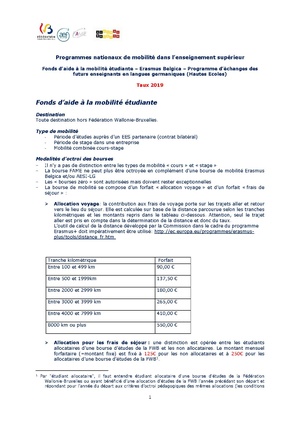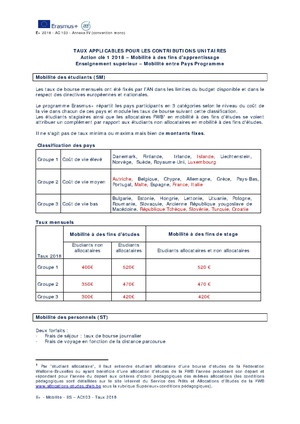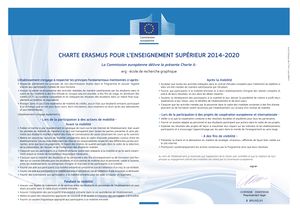International
De erg
Révision datée du 6 novembre 2019 à 15:30 par Sammy (discussion | contributions) (→Étudiant.e.s sortant.e.s / Outgoing students)
Sommaire
History
Since its creation in 1972, erg has defined itself as a research school where the activation of modes and spaces of production enables students to learn while developing a practice.
The articulation of the classes aims at forming a zone of convergence favoring the emergence of unexpected occurrences, of modes of exchange and collectiveness, and of hybridized forms, thus contributing to the training of citizen-artists in relation to the world, extending far beyond the curriculum. Here, what matters is not to offer certitudes, but to gather the conditions for a maximal degree of experimentation that pushes the students to position themselves in relation to their medium while de-constructing it for a better appropriation. In order to de-construct a medium, one needs to manipulate it.
The specificity of the erg’s teaching method lies in its inter- or trans-disciplinary approach, guaranteed by the way students and teachers interact across various disciplines: video, painting, photography, sculpture, drawing, installation-performance, digital arts, typography, graphic design, visual and graphic communication, illustration, comics, animation. In the Bachelor’s program, these interactions take place in pluri-disciplinary workshops organized as clusters: Art, Narration and Media. In the Master’s program, four programs are proposed: Art Practice, Critical Tools (Art and Simultaneous Contexts), Narrative and Experimentation (Speculative Narration), Politics and Experimentation in Graphic Design (Politics of the Multiple / Practices of Graphic Design and Artistic Complexity). Students also have the opportunity to familiarize themselves with other practices through in-school internships, during workshops organized by the teachers with external guests and open to multiple orientations, or through the use of various learning sites (video editing room, super 8 lab, sound lab, print lab, and so on).
For several years, erg has organized a series of partnerships with various schools in Europe and in the rest of the world. The school also offers opportunities to its students and its teachers to take part to the European mobility program Erasmus+. Bilateral exchanges and the Erasmus+ program allow students to expand their artistic knowledge in Europe, and build and develop projects likely to reinforce erg’s reputation as laboratory for artistic research. Erasmus+ gives the students (of all levels, including Doctorate, but except the first year of higher education) the opportunity to study at erg for a 3 to 12-month period within the framework of the agreements made between the institutions. The time passed in our school is fully recognized by the university of origin thanks to the ECTS – European Credit Transfer System.
Incoming students
In order to take part to the Erasmus+ program and study at erg, you need to meet the following requirements :
A/ To be a student registered in a higher education program leading to a recognized diploma (including doctorate) in one of the participating countries.
B/ To be a citizen of those countries (or hold a continuous (“A”) or permanent (“P”) passport)
C/ To have successfully completed at least the two first years in your institution.
If you wish to spend a semester at erg as an international / Erasmus student, please contact your school’s Erasmus coordinator to ensure there is an agreement between erg and your institution.
Application Documents
- Portfolio (digital only)
- Curriculum Vitae
- 2 ID photos
-All documents must be signed and approved by your school and sent by email only to Sammy Del Gallo - International Relations : email me-
Deadline for admission
15th of April 2020 for 1st semester ( September - January ) or full academic year (no incoming students in 2nd semester only)
- For non-French speaking students: CEFR level B1 is recommended as most of our courses are taught in French -
Download the Guide for incoming students
Étudiant.e.s sortant.e.s / Outgoing students
Les étudiant.e.s peuvent partir en échange international en Bac3 et Master1. En Master 1, les étudiant.e.s peuvent postuler pour une année complète à l’étranger. En Bac3, l’échange doit impérativement s’effectuer lors du 1er quadrimestre (septembre-février). Les étudiant.e.s conviennent avec l’erg d’un projet d’étude précis dans l’établissement d’accueil. A la fin de leur séjour ils doivent avoir validé le nombre d’ECTS demandés. Tout.e étudiant.e ne peut bénéficier qu’une seule fois de la bourse ERASMUS au sein d’un même cycle d’études, quelle que soit la durée du séjour. Les candidat.e.s Erasmus doivent également adresser à leurs enseignant.e.s d’Atelier Pluridisciplinaire et d’orientation une lettre de candidature détaillant leur motivation à partir en séjour d’échange, un portfolio artistique de leurs travaux récents et un descriptif de leur projet personnel. Après avoir examiné les dossiers de candidatures des étudiant.e.s, les enseignant.e.s d’orientation et d’AP, réunis en commission, marquent ou non leur accord à la demande d’échange et, en cas de candidatures multiples à un même établissement, sélectionne le/la candidat.e autorisé.e à postuler. Si le relevé de notes de l'étudiant.e présente après la session de janvier plusieurs échecs ou 1 échec supérieur à 2 points de balance (en-dessous de 8/20), la demande de candidature est automatiquement refusée.
étape 1 : télécharger, compléter et remettre le formulaire de candidature interne
étape 2 : soumettre par email un portfolio, accompagné d’une lettre de motivation et d’un descriptif du projet artistique personnel
étape 3 : après autorisation de la commission d’enseignant.e.s, envoyer l’ensemble des documents requis à l’institution choisie, dans les délais impartis
étape 4 : mise en ordre du dossier administratif à l’erg (remise de la fiche de réinscription et du plan d’études 2019-2020, paiement du minerval annuel)
---------------------------------------
Students can go on an international exchange in Bac3 and Master 1. In Master 1, students can apply for a full year abroad. In Bac3, the exchange must take place during the 1st quarter (September-February). Students agree with the erg on a specific study project in the host institution. At the end of their stay they must have validated the number of ECTS requested. All students may only benefit from the ERASMUS grant once in the same course of study, regardless of the length of their stay. Erasmus candidates must also send their Multidisciplinary and Orientation Workshop teachers a letter of application detailing their motivation to go on an exchange stay, an artistic portfolio of their recent work and a description of their personal project. After examining the students' application files, the guidance and AP teachers, meeting in committee, decide whether or not to approve the exchange request and, in the case of multiple applications to the same institution, select the candidate authorized to apply. If the student's transcript presents several failures or 1 failure greater than 2 balance points (below 8/20) after the January session, the application is automatically rejected.
step 1: download, complete and submit the internal application form
step 2: submit by email a portfolio, accompanied by a cover letter and a description of the personal artistic project
step 3: after authorization by the teacher board, send all the required documents to the chosen institution within the prescribed time frame
step 4: putting the administrative file in order at the erg (submission of the re-registration form and study plan 2019-2020, payment of the annual fee)
Partenaires / Partners
Albanie / Albania
Allemagne / Germany
– Akademie der Bildenden Künste München
– Braunschweig University of Art
– HFG Staatliche Hochschule für Gestaltung Karlsruhe – Faculty of Communication Design
– Hochschule fur Bildende Künste Hambourg
– Weißensee Kunsthochschule Berlin
Autriche / Austria
– University of Applied Arts of Vienna, Master Art & Science
Belgique / Belgium
Brésil / Brazil
– Universidade Federal de Minas Gerais
Canada
– UQAM
Chili / Chile
– Pontificia Universidad Católica de Valparaíso
Danemark / Denmark
– The Royal Danish Academy of Fine Arts, Schools of Visual Art
Espagne / Spain
– Universidad del País Vasco, Facultad de Bellas Artes
– Universidad Politécnica de Valencia, Facultad de Bellas Artes
Finlande / Finland
– Aalto University School of Arts, Design and Architecture
– Uniarts
France
– École de Communication Visuelle (ECV)
– Ecole supérieure d’art & de design Marseille-Méditerranée
– École d’enseignement supérieur d’art de Bordeaux
– École européenne supérieure de l’image, Angoulême et Poitiers
– École européenne supérieure d’art de Bretagne
– École nationale supérieure des arts décoratifs
– École nationale supérieure d’art de Dijon
– École nationale supérieure des beaux-arts de Lyon
– École nationale supérieure d’arts de Nancy
– École nationale supérieure d’arts de Paris Cergy
– École supérieure d’art et design, Grenoble / Valence
– École supérieure des beaux-arts, Tours / Angers / Le Mans
– Haute école des arts du Rhin (HEAR)
– Institut supérieur des beaux-arts, Besançon
Hong Kong
Hongrie / Hungary
– Moholy-Nagy University of Art and Design Budapest
Islande / Iceland
– Iceland Academy of the Arts, Department of Design & Architecture
Italie / Italy
– Accademia di Belle Arti dell’Aquila
– Accademia di Belle Arti Bologna
– Accademia di Belle Arti di Brera, Milano
– Rome University of Fine Arts
Lituanie / Lithuania
Mexique / Mexico
– Escuela Nacional de Pintura, Escultura y Grabado «La Esmeralda»
Monaco
– Pavillon Bosio, École Supérieure d’Arts Plastiques de la Ville de Monaco
Norvège / Norway
– Trondheim Academy of Fine Art
Pays Bas / Netherlands
– Koninklijke Academie van Beeldende Kunsten
Portugal
– Universidade de Lisboa, Faculdade de Belas Artes
République Tchèque / Czech Republic
– Brno University of Technology
Suède / Sweden
– Malmö Art Academy, Lund University
Suisse / Switzerland
– Bern University of Applied Sciences
- Edhea
Bourses de mobilité
Mobilité du personnel académique
Procédures OUT enseignants
Missions d’enseignement (STA)
Cette action permet au personnel enseignant dans un établissement d'enseignement supérieur et au personnel invité d'entreprise* d’effectuer une période d’enseignement dans un établissement d'enseignement supérieur d’un autre pays participant au Programme.
Les objectifs de la mobilité :
• encourager les établissements d’enseignement supérieur à élargir et enrichir l’éventail et le contenu des cours proposés
• permettre aux étudiant·e·s qui ne sont pas en mesure de participer aux programmes de mobilité de bénéficier des connaissances et de l’expertise d’enseignant·e·s et d’expert·e·s d'autres pays européens
• promouvoir l’échange d’expertise et d’expériences concernant les méthodes pédagogiques
• créer des liens entre établissements d'enseignement supérieur ainsi qu’avec les entreprises
Modalités:
• La sélection du personnel mobile relève de la compétence des institutions et doit être opérée de façon transparente, équitable et cohérente. Dans le cas d’expert·e·s du monde de l’entreprise, la mission de mobilité est lancée par une invitation de l'établissement d'enseignement supérieur à l’expert·e.
• Documents:
Les établissements d’enseignement supérieur, les entreprises partenaires et l’enseignant·e/expert·e conviennent à l'avance du programme des cours dispensés: programme d’enseignement. A la fin du séjour, l’institution d’accueil délivre à l’enseignant·e/expert·e une attestation de séjour. L’enseignant·e/expert·e conclut sa mission en rédigeant un rapport de mobilité.
• Aspects financiers :
La bourse est gérée par l’établissement d’enseignement supérieur d’origine dans le cas d’enseignant·e·s et par l’établissement d’accueil dans le cas d’expert·e·s invité·e·s, elle peut couvrir les frais de voyage et de séjour. Les modalités liées au financement de la mobilité doivent être précisées dans un contrat de bourse.


